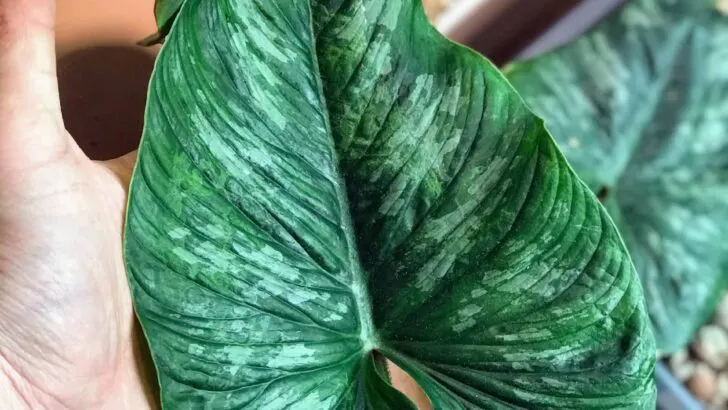The magnificent Philodendron mamei is a tropical perennial creeping plant that grows as ground cover and sometimes creeps up trees true to its epiphytic nature.
It has big green heart-shaped leaves with silvery dust markings on leaves as though smeared with fingers.
That’s how it has earned the name “Silver Cloud”.
The veins run deep, giving the leaves an almost pleated look. The leaves are less leathery than many other fellow species.
I love the distinct foliage but the real virtue is easy maintenance making Philodendron mamei care a cakewalk even for beginners.
Philodendron mamei Care
To care for Philodendron mamei use loose well-draining potting soil and a temperature between 65°- 80°F (18°C – 27°C) as well as bright indirect light. Water about once a week when the top 2” of soil (5cm) are almost dry and provide 60% or more humidity for optimal growth. Fertilize every 4-6 weeks in spring and summer using a balanced liquid fertilizer or use a slow-release fertilizer every 3-6 months.
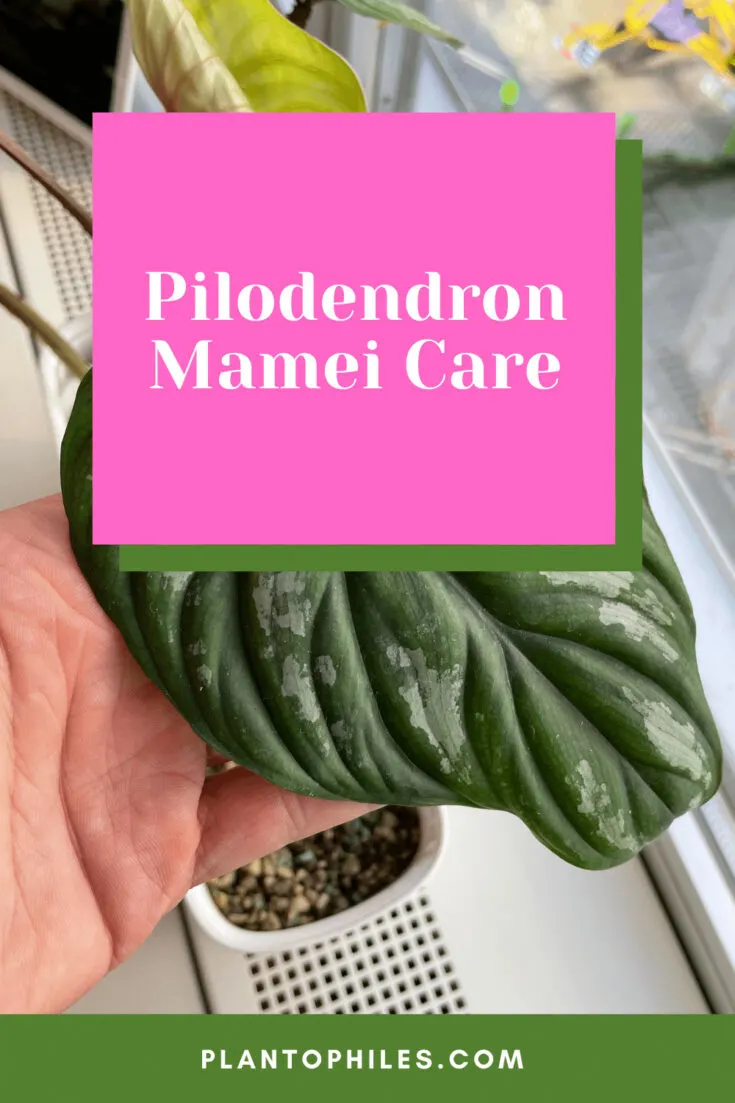
Pilodendron mamei Care
Philodendron mamei – The Plant
Before we dive into Philodendron mamei care it’s good to know it belongs to a very large genus of plants that has more than 500 species categorized under the family Araceae and are indigenous to the Ecuadorian rainforests.
Philodendrons were part of NASA clean air study and found effective in improving indoor air quality by removing formaldehyde.
Be careful where you grow Philodendron mamei as the plant contains calcium oxalate crystals which are toxic for pets causing mouth and bowel irritation.
Table of Contents
Philodendron mamei Plant Care Guide
@plantophilescom Philodendron mamei care #philodendronmamei #philodendronmameisilver #plantcare #plantcaretips #plantcarehacks #plantcaretipsfordummies #houseplants #houseplantsoftiktok
♬ MYSTERY GIRL – James Holt
Soil
Use well-draining potting soil to grow Philodendron mamei.
If you want to grow Philodendron mamei in a pot, you get the best results by using rich, loose potting soil that will drain well and is high in organic matter like your garden compost and mulch.
You can increase the drainage of regular potting soil by including peat, perlite and orchid bark as well as charcoal, peat moss, brick bits, coconut husk, etc.
Mixing sand is a good way to improve drainage if you grow Philodendron mamei outdoors.
They will thrive in organic matter rich soil, so use plenty of leaf mulch and sterile compost.
This also helps the soil retain moisture.
Pro tip: use a raised spot like the mound of a tree to grow Philodendron mamei – this way the landscape will allow for natural draining of excess water.
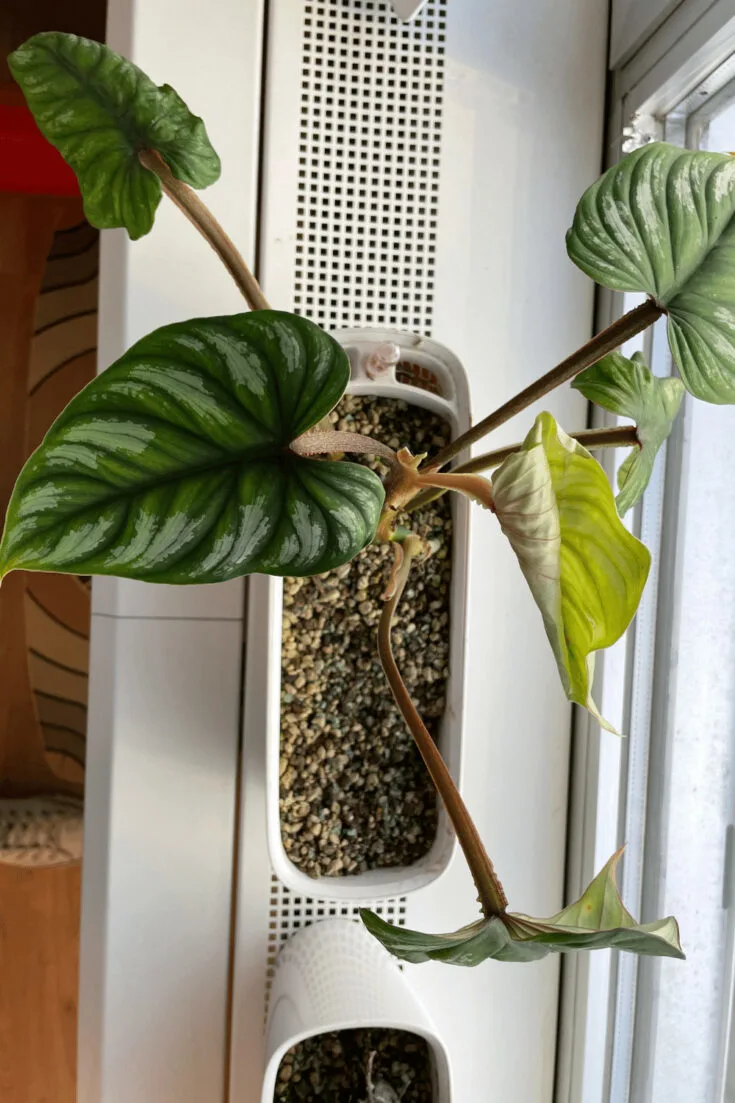
A long narrow pot and well-draining potting soil is best to grow Philodendron mamei
Light
Philodendron mamei grows best in brigh indirect sunlight.
According to the Global Biodiversity Information Facility, Philodendron mamei occurs in the understory of primary forests in Equador, sometimes occurring along stream banks in full shade.
Philodendron mamei care requires 70-85% sunlight.
Filtered sun is the best to grow the plant, so give it an east window side or a west window side spot.
USDA hardiness zones 9b to 11 are suited to grow Philodendron mamei outdoors.
In order to grow Philodendron mamei outdoors acclimatize the plant to the new location and beware that the plant is susceptible to sunburn.
Make sure it’s doing well in the new location before moving it out permanently.
Observe the leaf to get clues on lighting requirements for Philodendron mamei care.
The rich green means they need plenty of light to produce all that chlorophyll.
The silvery cloud patterns covering the leaf indicate they need to restrict the light, an adaptation to the paucity of light being under the canopy of large tropical trees and hence a lot of cool shade.
Therefore, I grow Philodendron mamei under the shade of a big tree in my garden and it’s been trailing along the ground and also creeping up the tree in wild glory.
If you live in the northern zones, it is best to grow Philodendron mamei indoors in a pot.
You can put them under fluorescent lights in the winter months.
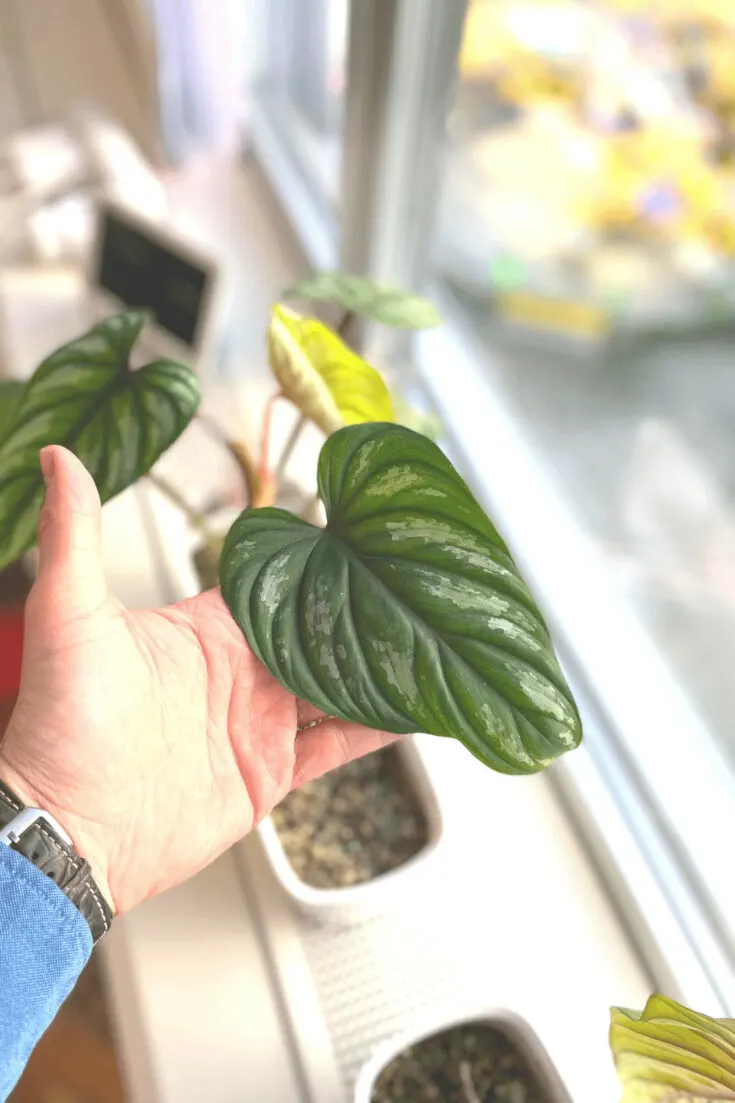
Philodendron mamei prefers bright indirect light
Watering
Water Philodendron mamei about once a week as a general rule of thumb and keep the soil slightly moist.
One important aspect of Philodendron mamei care is watering, which if you grasp, you’re sorted.
The plants are susceptible to root rot like most philodendrons and is the most common cause of death.
In my own experience, these plants love moisture but you can’t grow Philodendron mamei with the roots “sitting” in water.
This isn’t just a function of water but also soil which you can read up about in the above section.
I water just enough to keep the soil moist and that’s about once a week of deep drenching.
Then I let the topsoil dry out about a couple of inches.
That said, the optimal Philodendron mamei care changes according to time of the year, climatic zone and your specific growing conditions.
If you live in the tropics and grow Philodendron mamei outdoors in the ground, you can water it every other day.
If you grow Philodendron mamei in a pot that’s well-draining as explained above in the section on soil, let the 2-incehs (5cm) almost dry out before you drench again.
This is during the growing months i.e. spring and summer.
In the fall and winter, you can cut back on watering but don’t let the plant fall short of moisture as a general rule.
If you live in colder zones, indoors in a pot is the safest way.
Light watering about once or twice a week in summers and very minimal watering in winters is the way to go.
Temperature
Grow Philodendron mamei in a temperature between 65°- 80°F (18°C – 27°C).
Philodendron mamei care is dictated by its Ecuadorean origins.
It loves warmth and the best growth can be seen near the equator.
You can attempt to grow Philodendron mamei outside if the temperatures in your climatic zone are around 59°F (15°C) in the night and around 86°F (30°C) in the day.
It doesn’t do well in temperatures below 55°F (12.75°C).
However, if you want to grow Philodendron mamei them in northern zones, summer months are fine, but come autumn the temperature must never fall under 12.75°C (55°F).
In winters, you should promptly move the plant indoors always, as they are very chill sensitive.
Once it is away from frost and safely indoors, you can grow Philodendron mamei at temperatures between 65°- 80°F (18°C – 26°C) and in lower light conditions.
If it’s very cold indoors they may simply stop growing or reduce in size.
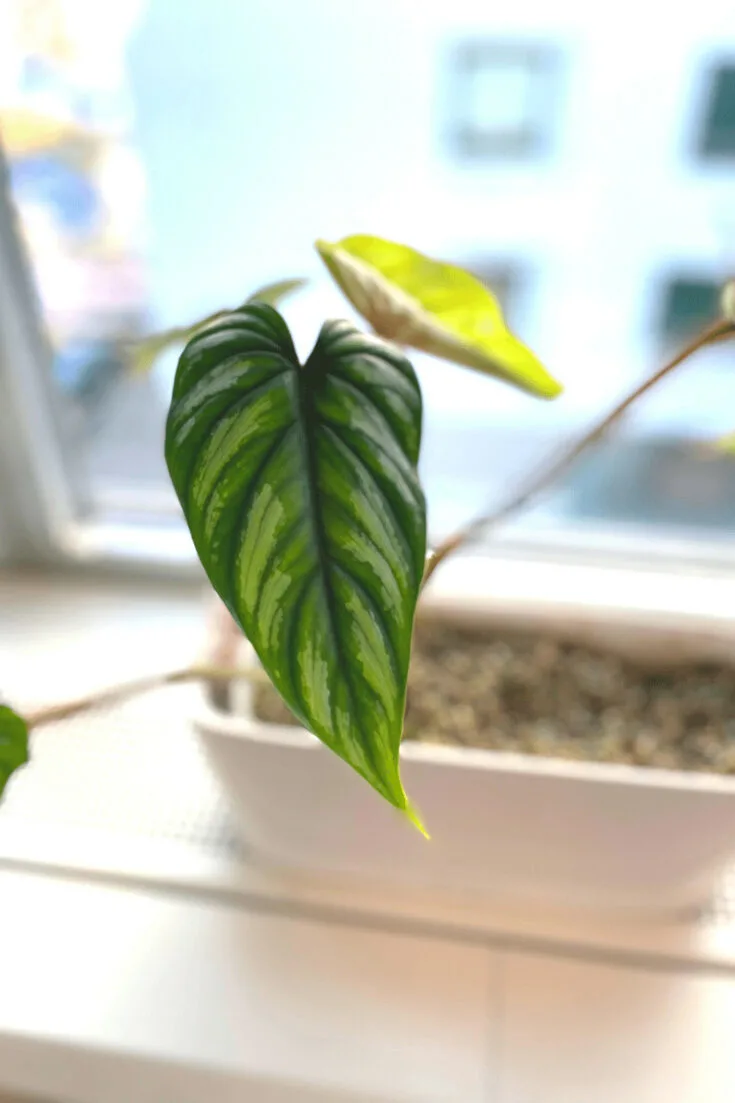
Philodendron mamei grows best in a temperature between 65-80 degrees Fahrenheit (18-27 degrees Celsius)
Humidity
Provide 60% humidity or more for Philodendron mamei.
As with all tropical plants a humid environment is good to grow Philodendron mamei.
You can use humidifiers to give your Philodendron mamei the right environment through dry months.
That said, you can grow Philodendron mamei in low humidity conditions as well but it will grow better in high humidity above 60%.
Like I said before, they have “ideal” conditions but they are quite tolerant and forgiving.
Fertilization
Fertilize Philodendron mamei every 4-6 weeks in spring and summer using a liquid balanced organic fertilizer or use a slow release fertilizer every 3-6 months.
I grow Philodendron mamei in a soil mix rich in organic manure and also give it additional feeding.
Decomposed leaf and bark matter mixed with the soil acts as organic food for the plant, but a little extra feeding won’t come amiss here.
Nitrogen fertilizer will increase leaf size and produces a larger, healthier plant, which is very desirable particularly if you grow Philodendron mamei for ground cover outdoors.
Even potted plants grows better with regular feeding.
For potted Philodendron mamei care, you can schedule a routine dose of balanced organic fertilizer which you can pick up from your local store.
Something like a fish emulsion well diluted and administered every 4 to 6 weeks gives a real boost to the growth.
This is to be used only in the growing months. Remember to cut back on feeding the plant in winters.
The reason I prefer organic feed over chemical fertilizers, particularly for aroids like philodendrons is that they are slow-release and safe to use.
If you’re using a chemical fertilizer I would recommend you go for balanced liquid foliage boosting one.
This allows you to cut down the concentration more easily. You should thin down the concentration of the fertilizer to half the prescribed level.
Excessive fertilization curls the tip of the leaves and even kills the plant.
If you’re propagating, your juvenile Philodendron mamei care will need fertilization. If left unfertilized they tend to grow very slowly.
Use a triple diluted solution for young plants once the roots are well established.
Pro-tip: Use good quality balanced foliage fertilizers. Heavy salts in cheaper fertilizers will damage the roots and possibly kill the plant.
Propagation
The easiest way to Propagate Phildendron mamei is to take a stem cutting containing at least one node.
Philodendron mamei are aroids i.e. plants that reproduces through monocotyledonous inflorescence that come with a spathe and spadix.
The spadix contains male, female and sterile flowers. When the female flowers are mature they become receptive to pollen from the male flowers.
The University of Chicago examines this interesting phenomenon very closely across several species in the genus, Philodendron.
If you’re an aroid enthusiast like me, this makes for a good academic read.
I’ve come across people having mixed experiences with Philodendron mamei propagation.
Some find it that it takes root readily while others struggle with it.
Tip/stem cutting, basal branches or plantlets and layering are the usual methods for home growers.
Don’t let a few unsuccessful attempts deter you from persisting.
Read on for a step-by-step guide on how to propagate and grow Philodendron mamei below.
At one time Philodendron mamei was both rare and expensive but due to the use of “tissue culture” in propagation of Philodendron mamei used by nurseries, it has become common.
Tissue cultured plants don’t often achieve the size nor beauty of a wild collected specimen due to the chemical processes used in their cloning.
Growth
Philodendron mamei is a crawling philodendron but it will also climb if you provide a sphgnumm moss pole and look like a climber.
The best way to grow Philodendron mamei indoors is around a tall sphagnum moss totem because these plants are natural creepers.
The leaves will remain a moderate size when grown like this.
The plant grows 1 meter (3.2 feet) high in such conditions. Tip pruning will encourage bushiness, and also give you pieces to propagate.
As you know, I grow Philodendron mamei as groundcover under the shade of a tree.
I’ve observed, it is not a particularly fast grower but it can eventually cover quite a large area even up to 5 metre diameter.
It is easily pruned and kept under control to a limited area too.
Proper Philodendron mamei care in the right conditions can result in leaves even spanning up to 50cm (1.5 feet) across in mature plants outdoor plants.
Potting
For patio and indoors you can grow Philodendron mamei in fairly large pots. The ideal Philodendron mamei care would require a 10″ (25cm) diameter, 10″ (25cm) deep container to start with and very well aerated soil.
If the roots get to breathe you can grow Philodendron mamei more reliably.
These plants are not necessarily root bound and don’t prefer cramped potting. Repot about once a year or when the plant gets bigger.
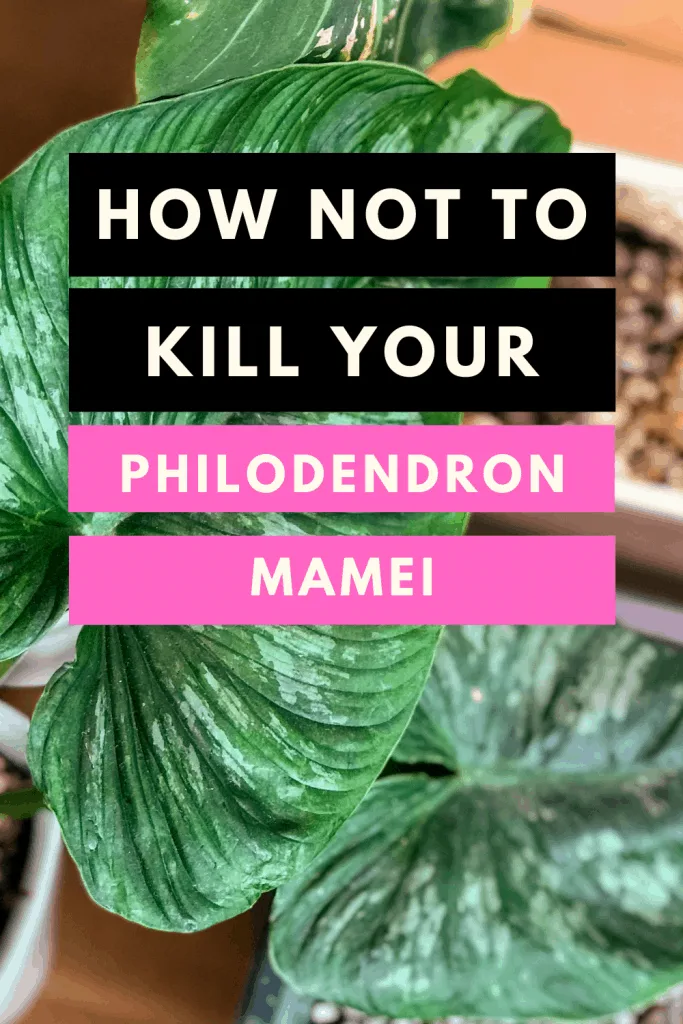
Philodendron mamei care
Philodendron mamei propagation methods
Nurseries propagate philodendrons from seeds or through tissue culture.
Both of these techniques are not feasible for home-growers.
I have shared below some methods that have worked for me.
The first rule of Philodendron mamei care during propagation is that you should do it ONLY in the growing season, when the weather is relatively warm and humidity is moderate to high. Spring is the ideal time.
Propagate Philodendron mamei from cuttings
1. Choose a strong healthy vine from the mother plant from the soil end of the creeper
2. Cut the stem tip with at least three nodes and a terminal using a pair of sharp garden scissors. The nodes near the soil take root more reliably. Even better if you can see aerial roots on the nodes.
3. Pinch the leaves at the bottom node.
4. Keep a pot with a 50-50 mix of sphagnum moss and perlite that’s evenly very moist but not wringing wet.
5. You don’t need a rooting hormone for the cuttings because they typically root quite readily.
6. Stick in the stem with at least one node well under the soil and press down the soil for support.
7. Keep the pot in a fairly bright spot but away from direct sun.
8. Keep the soil moist until the cutting is established. This should take 1 – 2 weeks.
Propagate Philodendron mamei from basal branches
1. The mother plant will branch out at the base and the new branch will throw root towards the soil.
2. Once the roots are established you can carefully cut the branch off the main plant.
3. You’ll know if the roots are established if they are firmly fixed in the soil when you tug at them.
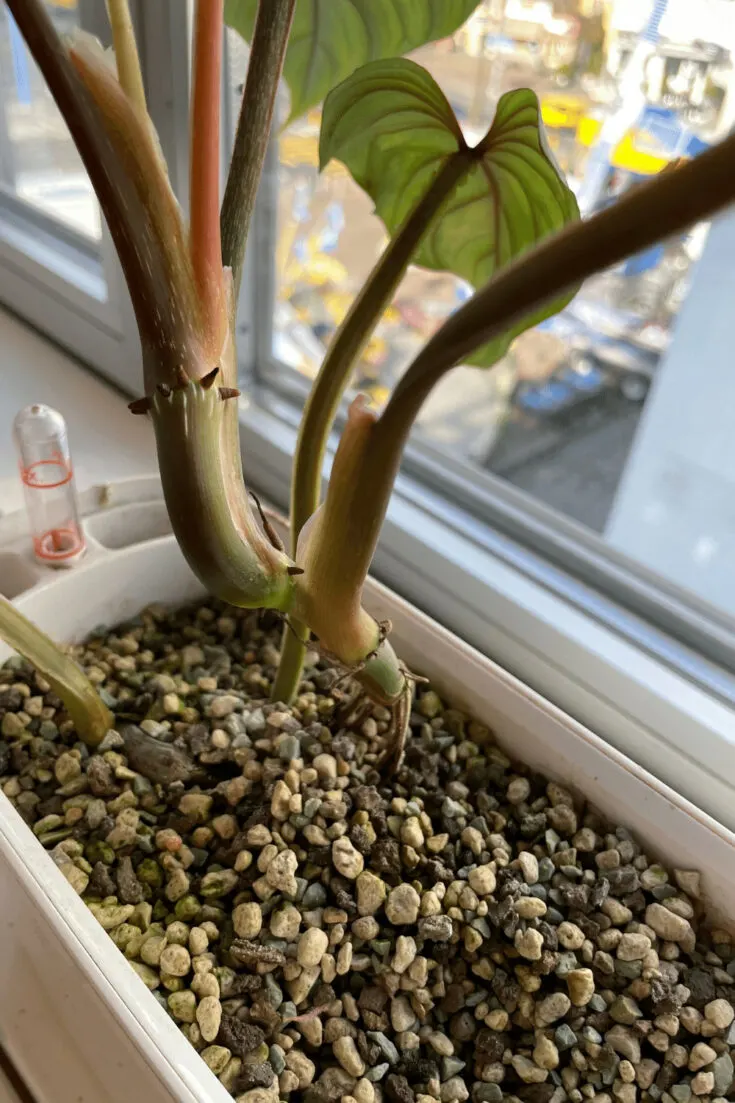
Philodendron mamei is a crawling philodendron
How to air-layer your Philodendron mamei
You’ll need a 6” transparent plastic bag, sphagnum moss and a few twisty ties.
1. Look for small aerial root projections in your older leaf nodes.
2. Punch a few small holes at the bottom of your plastic bag and put a fistful of evenly moist sphagnum moss at the bottom. Cut the top end of the plastic bag such that you get flaps to roll around a stem.
3. Now let’s get to the plant. With one palm hold the water-soaked moss in the plastic bag, against the aerial root on the stem. With the free hand wrap the plastic flaps around the stem. Secure this bag of moss to the stem with twisty ties making a nice wet moss cocoon for the roots to grow into.
4. Make sure your peat moss cocoon doesn’t slip off the root node.
5. Keep the moss moist by watering through the holes on the plastic.
6. After a couple of weeks, you’ll notice that roots have grown into the moss.
7. Remove the plastic and the moss carefully without breaking your new roots.
8. With a sharp garden scissors cut the stem below the new roots and separate the cutting from the mother
9. Pot the cutting using the guidelines given in the section on ideal soil for Philodendron mamei care and keep the soil moist until the new plant is well-established.
10. Pro tip: for better chances of success do this for multiple nodes at one time so that at least one of them catches root.
Common Problems with Philodendron mamei
Sudden wilting of leaves or yellowing: This typically happens due to a root rot caused due to over watering or due to a fungal infection of the roots.
Root rot usually results from a soil mix that does not drain quickly or overly frequent watering.
Check the base of the plant immediately.
I would salvage a few cuttings and try to propagate them separately in a fresh pot with sterile well-draining soil.
Irregular tan patches on the leaves: This could be due to a bacterial infections like sometimes seen in Philodendron mamei such as Erwinia blight or Pseudomonas leaf spot.
You can tell if the infection is bacterial from the typical disagreeable smell the plant emanates. The disease normally affects smaller plants and appears to be less severe on large plants grown in the ground.
This bacterial infection needs moisture to spread.
First of all, isolate the plant from all other plants in your garden, cut away the affected leaves, minimizing watering and stop misting the plant, keep the leaves dry or allow them to dry very quickly in order to control spreading. Bactericides are typically not needed.
Dark patches on the leaf: This could be due to cold draft exposure. Cut off the damaged leaves and move your plant to a warmer location.
Yellow leaves / brown leaves: If you notice the edges getting brown and dry then you’re underwatering. If the leaves turn yellow and the soil feel soggy it could be sign of overwatering.
Pale color: Leaves lacking the characteristic dark green color is typically a straightforward indicator of poor lighting. You should move your plant to a brighter spot
Common pests: When you grow Philodendron mamei, pests and insects are not something to worry about.
The common pests of this plant species include aphids, moths (worms), fungus gnats, mealybugs, scales, shore flies and thrips.
The best control measure is a routine application of insectidal soap and neem oil once a month or as prescribed on the package.
My Philodendron mamei care routine for pest control includes washing down the leaves with a water once a week when I water the plant and wiping them dry.
Severe infestations require more detailed treatment typically involving chemicals.
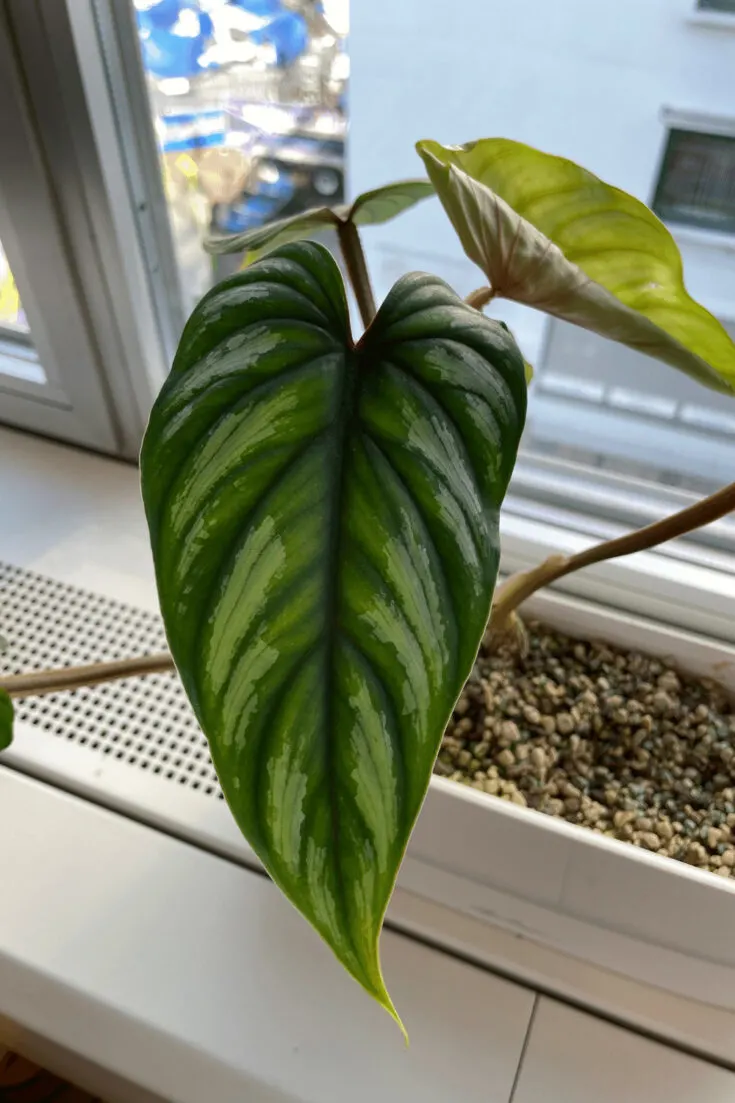
Philodendron mamei has silvery blotches on the adaxial leaf side
Tips to keep Philodendron mamei problem-free
These are some hacks for Philodendron mamei care that I’ve learnt over the years.
– The ideal temperature range is between 65°- 80°F (18°C – 27°C)
– Indirect sunlight is the best to grow Philodendron mamei.
– Avoid temperature shocks like taking it suddenly indoors or outdoors. Acclimatize the plant before moving it.
– Use a nitrogen fertilizer for increased leaf size and a larger, healthier plant
– Keep the soil evenly moist during growing months but never water logged
– Wash the leaves regularly to prevent pests and dust accumulation. But make sure to dry out the leaves after washing.
– High humidity promotes lush growth and shiny foliage, so it is a good idea to mist the plant regularly.
– Frequent watering in winters will kill the plant.
– Grow Philodendron mamei in a big planter with loose soil and necessarily with a totem.
– Repotting is ideally done in spring, before the plant begins active new growth.
– Ideal for outdoor planting if you’re looking for ground cover.
– Pruning is recommended as a general practice
– Remove the dead leaves and branches to avoid spreading infections.
Frequently Asked Questions About Philodendron mamei
Is Philodendron mamei pet-friendly?
ASPCA reports that philodendron is toxic to dogs and cats. The plant contains insoluble calcium oxalate crystals similar to other plants in the Araceae family. Chewing or biting into this plant will release these crystals causing tissue penetration and irritation the mouth and GI tract. Pets that consume any part of the plant may exhibit vomiting, pawing at the mouth, lack of appetite, and drooling.
Does Philodendron mamei purify air?
You can grow Philodendron mamei for their air purifying properties. These plants help in removing common household toxins from the air, like formaldehyde making it a healthy addition for your space. The NASA studies on indoor pollution done in 1989 recommends 15 to 18 plants in 6 to 8-inch- diameter containers to clean the air in an average 1,800 square foot house.
Can you grow Philodendron mamei from seeds?
For seeds the Philodendron mamei needs to flower and when grown indoors in pots they rarely do so. The seeds have limited longevity unless it is properly processed and vacuum packed. This is usually the method adopted by professional nursery growers and not by home garden enthusiaists
How do I make Philodendron mamei look fuller?
This type of self-heading philodendron doesn’t take to well to pruning. The way to make it look fuller is by giving it sufficient foliage inducing fertilizer. Also, Philodendron mamei is a big leaved plant and just a few leaves can fill up the space.
Does misting Philodendron mamei help?
Periodically showering the plant with water and applying insecticidal soap will help keep pests at bay. Just watch out for bacterial infections which spread due to moisture.
Conclusion About Philodendron mamei Care
Philodendron mamei is a great one to start with if you’re a beginner at gardening and you’re enthusiastic about greening up your space.
I recommend you go through our houseplant tips. In fact, I would also encourage you to try out Marble Pothos, Philodendron Brandtianum, or Philodendron Billietiae, all of which are suitable plants to growing indoors.
Happy growing!

